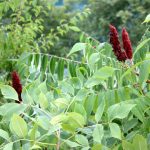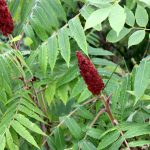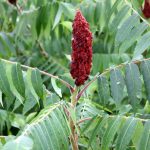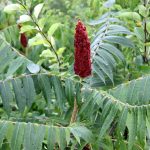|
Rhus typhina L., Cent. Pl. II 14 1756. (Syn: Datisca hirta L.; Rhus hirta (L.) Sudw.; Rhus typhina f. typhina ; Toxicodendron typhinum (L.) Kuntze);
.
Rhus typhina syn. R. hirta, the staghorn sumac[1] or stag’s horn sumach, is a species of flowering plant in the family Anacardiaceae, native to eastern North America. It is primarily found in Southeastern Canada, the Northeastern and Midwestern United States and the Appalachian Mountains,[2] but is widely cultivated as an ornamental throughout the temperate world.
Rhus typhina is a deciduous shrub or small tree growing to 5 m (16 ft) tall by 6 m (20 ft) broad. It has alternate, pinnately compound leaves 25–55 cm (10–22 in) long, each with 9–31 serrate leaflets 6–11 cm long.[4] The leaf petioles and the stems are densely covered in rust-colored hairs. The velvety texture and the forking pattern of the branches, reminiscent of antlers, have led to the common name “stag’s horn sumach”.[5]
Staghorn sumac is dioecious, and large clumps can form with either male or female plants.[6] The fruit is one of the most identifiable characteristics, forming dense clusters of small red drupes at the terminal end of the branches;[4] the clusters are conic, 10–20 cm (4–8 in) long and 4–6 cm (2–2 in) broad at the base. The plant flowers from May to July and fruit ripens from June to September.[7] The foliage turns to brilliant shades of red, orange and yellow in autumn (fall).[5] The fruit has been known to last through winter and into spring.
Staghorn sumac spreads by seeds, and by rhizomes to form colonies, with the oldest plants in the center, and the younger plants radiating out.[4] It grows quite aggressively.
In late summer it sometimes forms galls on the underside of leaves, caused by the sumac leaf gall aphid, Melaphis rhois. The galls are not harmful to the tree.
Some beekeepers use dried sumac bobs as a source of fuel for their smokers.
The fruit of sumacs can be collected, soaked and washed in cold water, strained, sweetened and made into a pink lemonade.[10] The leaves and berries of staghorn sumac have been mixed with tobacco and other herbs and smoked by Native American tribes.[11] This practice continues to a small degree to this day.
All parts of the staghorn sumac, except the roots, can be used as both a natural dye and as a mordant. The plant is rich in tannins and can be added to other dye baths to improve light fastness. Harvest the leaves in the summer and the bark all year round.[12]
Fotos taken in 2009. Germanname Essigbaum, Hirschkolbensumach
Englishname Stanhorn Sumac The Name suggests: google translator says: the strong, brown and hairy tomentose young shoots, reminiscent of an overgrown deer antlers in velvet.
Hope you understand.
This spring our neighbours cut down their tree but the seeds spread all oven in their as well as in our garden. And it was a lot of work to pull out the yound shoots. Some young plants that we could not reach habe Good one…
As Doctor we are more aware of Staghorn calculus in Kidneys rather than the true Stag Horn. This one is another one. Wild Bushes for ID : Niagara Falls,New York : 24NOV17 : AK-32 : 5 posts by 2 authors. Attachments (3) Again seen in the last week of June in the Niagara Falls area. Appears to be Staghorn Sumac aka Rhus typhina. The teeth on the leaves tell me that it is not the poison Sumac. .
Awesome photos. I have also seen this near Niagara falls. . References:
|
Rhus typhina (Germany/ USA)
Updated on December 24, 2024




